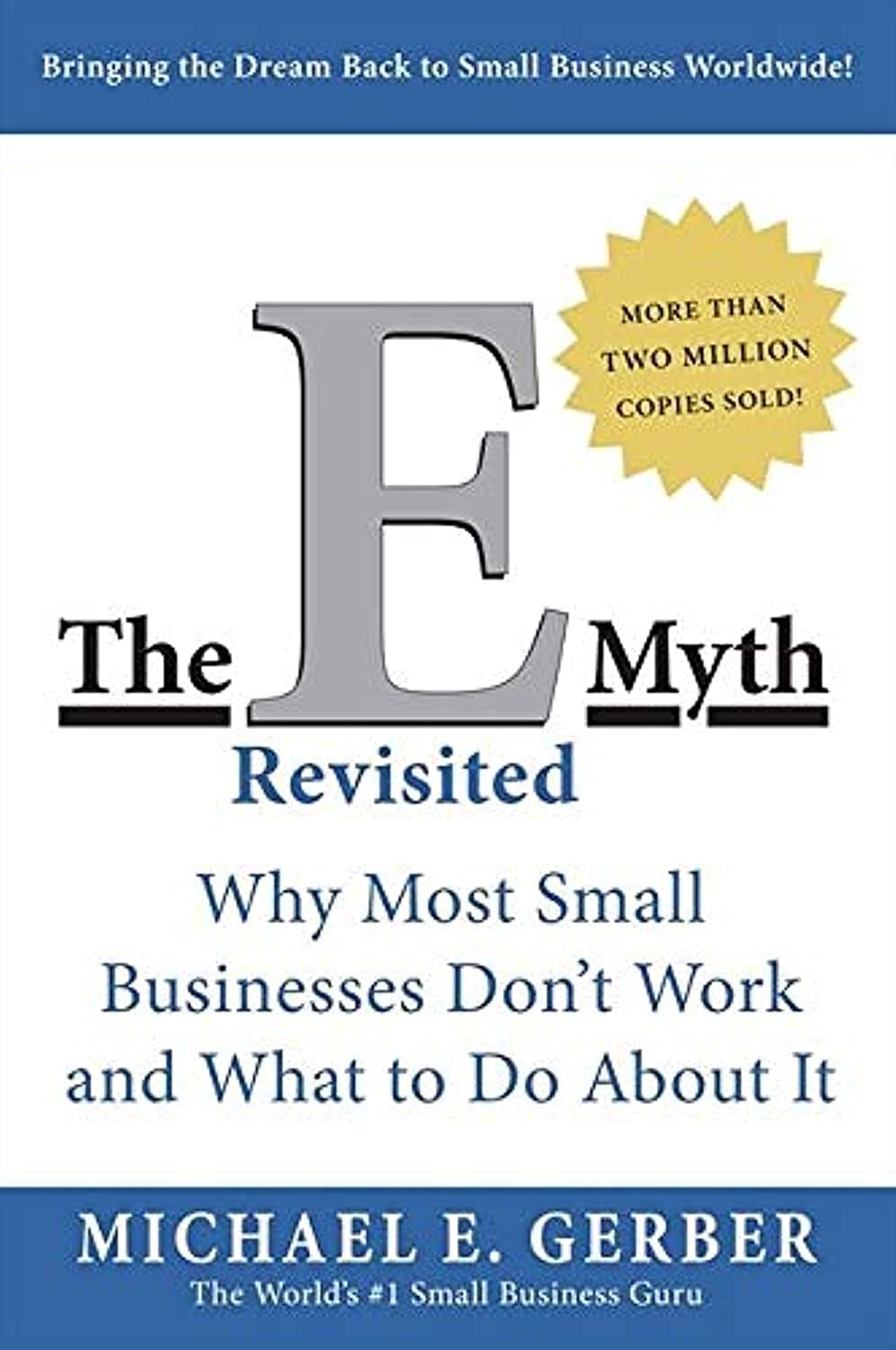
THE E-MYTH REVISITED: A SUMMARY
Introduction
Idea 1
Entrepreneurs risk capital to make a profit.
Idea 2
The Turn-Key revolution is changing who goes into business how they do it, and their likelihood for survival.
Idea 3
The business development process, when it is systemized and applied purposefully by a small business owner has the power to transform.
PART I: THE E-MYTH AND AMERICAN SMALL BUSINESS
Chapter 1
The Entrepreneurial Myth
After meeting thousands of businesspeople, Mr. Gerber feels if the entrepreneur existed inside them, it was only for a moment. What was left was only a myth that grew out of a misunderstanding about who goes into business and why. He believes most small businesses are not started by entrepreneurs.
The Entrepreneurial Seizure
He describes this as someone who is working for someone else and performing technical work. Good at this work. And one day, for whatever reason was stricken with an entrepreneurial seizure and uncontrollable need to start your own business.
The Fatal Assumption
Many fall victim to the assumption that because they understand the technical work of a business, they understand a business that does that technical work.
These things are not the same. The fact that they know how to perform the technical work of the business is their single greatest liability.
The technician suffering from an entrepreneurial seizure takes the work he loves to do and turns it into a job.
Chapter 2
The Entrepreneur, the Manager, and the Technician
Anyone who starts of business is acting as three people in one. The Entrepreneur, the manager and the technician.
The Entrepreneur
The visionary who craves control of the future and sees nothing but opportunity. Lives in the future.
The Manager
The pragmatic planner who loves order, hates chaos and invariably sees problems. Lives in the past.
The Technician
The doer who gets things done. Loves to tinker. Loves to work. Lives in the moment.
Chapter 3
Infancy: The Technician’s Phase
There are three phases of a business’s growth:
- Infancy
- Adolescence
- Maturity
Infancy
In the first phase of a business started by a technician, they work a zillion hours. The owner of the business and the business are one and the same.
The business itself becomes The Boss you thought you were going to get away from.
For the technician, the selfish desire to do the work they love is precisely what is holding the business back.
Chapter 4
Adolescence: Getting Some Help
So you hire help. Most at this stage perform management by abdication, rather than delegation. At first it’s great, but then balls start to drop. And you realize no one cares about your business the way you do.
Chapter 5
Beyond the Comfort Zone
The technician’s comfort zone is defined by how much they can do themselves.
Getting Small Again
Rather than solve these problems and grow sometimes businesses up for the solution of going back to being small.
Going for Broke
The other alternative is to just keep going faster and faster until it self-destructs under its own momentum.
Adolescent Survival
He feels the most tragic possibility of all for an adolescent business is that it actually survives! Through great determination and insane hours, you manage to persevere and continue your insane lifestyle. Horrible.
A mature company is started differently from the very beginning. It’s about building a business that works without you, not building a business because of you.
Chapter 6
Maturity and the Entrepreneurial Perspective
The Entrepreneurial Perspective
This is an outline from Tom Watson the founder of IBM.
- Have a clear picture of what the company would look like when it was finally done.
- Ask yourself how company that looked like that would have to act.
- Realized that unless we act that way from the beginning, we will never get there.
The entrepreneur asks “How must the business work?” while the technician asks “What work has to be done?”
The Entrepreneurial Model
The entrepreneurial model sees the business as the product itself. When entrepreneurs create a business model, they ask “where is the opportunity.” They create a solution that solves the frustrations of certain group of customers. The solution is what the customer wants, not the Entrepreneur, so it is critical to have a clear picture of exactly who that customer is.
PART II: THE TURN-KEY REVOLUTION: A NEW VIEW OF BUSINESS
Chapter 7
The Turn-Key Revolution
He feels the Turn-Key Revolution was the ultimate balanced model of a business that works.
The Franchise Phenomenon
He uses McDonald’s as a case study.
The Most Successful Small Business in the World
This is what McDonald’s calls itself to this day. Ray Kroc created a model upon which an entire generation of entrepreneurs have built their fortunes.
Turning the Key: The Business Format Franchise
This is an entire system of doing business. It means the true product of business is the business itself.
Selling the Business Instead of the Product
Business-as-a-product will only sell if it works without you.
Chapter 8
The Franchise Prototype
The Business Format Franchise really is a proprietary way of doing business that successfully differentiates itself from every one of its competitors. To an extent, every great business in the world is a franchise. How do you build yours?
Chapter 9
Working On Your Business, Not In It
Your business is not your life.
Pretend that your business will be the prototype for 5,000 more just like it. Here are rules to follow to build a winning business:
- “The model will provide consistent value to your customers, employees, suppliers, and lenders beyond what they expect.
- The model will be operated by people with the lowest possible level of skill.
- The model will stand out as a place of impeccable order.
- All work in the model will be documented in Operations Manuals.
- The model will provide a uniformly predictable service to the customer.
- The model will utilize a uniform color, dress, and facilities code.”
If your business depends upon finding people highly skilled people, it will be impossible to replicate. You want your business to be systems dependent rather than people dependent.
Great businesses are not built by extraordinary people, but by ordinary people doing extraordinary things.
- Michael E. Gerber Tweet
PART III: BUILDING A SMALL BUSINESS THAT WORKS!
Chapter 10
The Business Development Process
Innovation
It is not the product that demands innovation, but the process by which it is sold. Aim your innovative energy toward determining how your business does business. What is standing in the way of your customers getting what they want? Innovation is the mechanism through what your business identifies itself in the mind of your customers, and establishes its individuality. The results are a quantifiably verifiable profile of your customers perceived needs and unconscious expectations. Innovation is the signature of a bold imaginative brand.
Quantification
Quantify everything. You’ll learn which numbers are critical and which are not. Without numbers you can’t possibly know where you are.
Orchestration
If you haven’t orchestrated it, you don’t own it. And if you don’t own it, you can’t depend on it. And if you can’t depend on it, you don’t have a franchise. And by “franchise” in this instance, he means a proprietary way of doing business that differentiates you from everyone else. Unless your unique way of doing business can be replicated every single time, you don’t own it. You must have a system that provides the vehicle to facilitate predictability. An orchestrated system means your people provide predictable results, giving a customer what they want every single time.
This is a never ending process. You must continue to innovate, quantify and orchestrate. The process is dynamic because the world is dynamic so it must constantly evolve and be tested.
Chapter 11
Your Business Development Program
In this chapter he explains the 7 steps of a Business Development Program:
- Your Primary Aim
- Your Strategic Objective
- Your Organizational Strategy
- Your Management Strategy
- Your People Strategy
- Your Marketing Strategy
- Your Systems Strategy
The rest of the book walks you through the steps in detail.
Chapter 12
Your Primary Aim
Define your Primary Aim by asking questions that clarify what you want your life to be. Without this clarity how would you know the first steps to take? How would you measure your progress or know how far you’ve gone?
Great people create their lives actively, while everyone else is created by their lives, passively waiting to see where life takes the next.
- Michael E. Gerber Tweet
Before you start a business ask yourself the following:
- What do you want your life to look like. Day-to-day?
- What would I like to be able to say I truly know about my life?
- What do I want my relationships to be like with family, friends, customers, employees and community?
- How do I want to be thought of by others?
- What do I want to be doing 2, 10 or 20 years from now?
- What specifically would I like to learn spiritually, intellectually, financially, physically, along the way?
- How much money will I need to do those things?
Chapter 13
Your Strategic Objective
The First Standard: Money
How much money do we need to live the life we want and retire like we want?
The Second Standard: An Opportunity Worth Pursuing
Can this business fulfill the financial standards you’ve created for your primary aim and your strategic objective?
What Kind of Business Am I In?
A commodity is the item with which your customer walks out of the store. But the product is what your customer feels as they walk out of your business. What feeling are you selling? Peace of mind? Power? Love?
Who Is My Customer?
Every business has an essential demographic model or a most probable customer. What motivations propel that customer? How successfully can you satisfy the emotional or perceived needs in the customer’s mind?
Standards Three Through….?
Are you going to be local, regional, or global? Are you going to be retail or wholesale? What other questions do you need to ask yourself?
GRKKT: Here the author provides a great case study on putting all of the above into action.
Chapter 14
Your Organizational Strategy
In this chapter, Michael tells a story of Jack and Murray, who went into business together. At first things were great, and everything was organized, but as they grew, they begin to have problems.
Organizing Your Company
You should outline all shareholder and employee positions clearly, defining who does what. From Chief Operating Officer to VP of Finance to VP of Sales to VP of Marketing to the Service Manager to Accounts Payable, write up all the titles and outline all the job descriptions. Create an org chart. Your organizational chart comes from your strategic objective, which is driven by your primary aim.
As Jack and Murray’s business grows, they have a clear understanding for which positions they need to hire.
Prototyping the Position: Replacing Yourself with a System
If Jack and Murray’s business is going to survive, they must find people to do the tactical work so they can focus on the strategic work. For example, they must create a Sales Operations Manual. In the book, Michael goes into more detail as to what this means.
Chapter 15
Your Management Strategy
You don’t want your business to be dependent upon finding amazingly competent people. Your System is your management strategy because it protects you from the unpredictability of people.
What is a Management System?
It is a method of creating automatic results from your business, which you will use as a marketing tool.
In going to a hotel, the author had the same positive customer service experience. They delivered his favorite brand of coffee, newspaper, and mint. It’s not the coffee or the newspaper in and of itself. It’s the fact that he felt heard. How do you create the same consistent experience that makes customers feel heard?
Answer: you must create an Operations Manual. This will systemize processes with clearly defined roles, checklists and approval signatures. Create a system for everything.
GRKKT: Here the author provides a great case study on putting all of the above into action.
Chapter 16
Your People Strategy
Make your business a symbol of the things you believe in. Employees will have respect for the work they do if they have respect for the boss.
You become the creator of the impact on the world of the work you do.
- Michael E. Gerber Tweet
In Michael’s example, the hotel, the importance of the work was broken down into three parts:
- The customer is not always right, but it’s our job to make them feel that way.
- Everyone who works here is expected to work towards being the best they can be, or at least act like it until they get around to it.
- The business is a place where everything we know how to do is being tested by what we don’t know how to do. This is what creates growth and meaning.
The Rules of the Game
In order to help motivate people to follow the Operations Manual, Michael suggests creating a “people game.” However, there are some rules you must follow in creating the game.
- Never figure out what you want your people to do and then try to create a game out of it.
- Never create a game for your people that you are unwilling to play yourself.
- Make sure there are specific ways of winning the game without ending it.
- Change the game from time to time. The tactics, not the strategy.
- Never expect the game to be self-sustaining. People need to be reminded of it constantly.
- The game has to make sense.
- The game needs to be fun from time to time.
- If you can’t think of a good game, steal one.
GRKKT: Here the author provides a great case study on putting all of the above into action.
Hiring Process
Here Michael outlines a hiring process:
- A scripted presentation communicating the boss’ idea in a group meeting to all the applicants at the same time.
- Meeting with each applicant individually to discuss his reactions to and feelings about the idea, as well as his background and experience. Ask each applicant why they are qualified.
- Notification of the successful candidate by phone.
- Notification of the unsuccessful applicants, thanking each for their interest. Standard letter signed by interviewer.
In short, the medium of communication became as important as the idea it was designed to communicate.
- Michael E. Gerber Tweet
Onboarding
First day of training to include the following activities for both the boss and the new employee:
- Review the boss’s idea.
- Summarize the system through which the entire business brings that idea into reality.
- Take a tour of the facilities, highlighting people at work, systems at work, to demonstrate the interdependence of systems on people and people on systems.
- Answer clearly and fully all of the employee’s questions.
- Issue a uniform and the Operations Manual.
- Review the Operations Manual, Strategic Objective, Organizational Strategy, and the contract.
- Complete the employment papers.
Hierarchy of Systems
- How we do it here.
- How we recruit, hire, and train people to do it here.
- How we manage it here.
- How we change it here.
Chapter 17
Your Marketing Strategy
Forget about what you want and focus on what the customer wants. This is the only thing that matters.
So the famous dictum that says, ‘Find a need and fill it,’ is inaccurate. It should say, ‘Find a perceived need and fill it.’
- Michael E. Gerber Tweet
Two Pillars of Marketing
The two pillars of a successful marketing strategy are:
- Demographics is the first marketing pillar. This describes who your customer is.
- Psychographics is the second marketing pillar. This describes why your customer buys.
The best way to learn about your customers is to ask them questions. Don’t create a logo that looks pretty with colors chosen by your wife. Ask customers. Everything is driven by customers. Become interested in the science of marketing and business.
Chapter 18
Your Systems Strategy
“A system is a set of things, actions, ideas, and information that interact with each other and in so doing, alter other systems. In short, everything is a system.”
There are three kinds of systems in your business:
- Hard Systems
- Soft Systems
- Information Systems
The innovation, quantification, orchestration and integration of these three kinds of systems is what determines the success of your systems strategy.
GRKKT: When trying to determine a comprehensive list of systems and resources, I would also recommend checking out Business Model Canvas.
Hard Systems
This could be your facility, a white board or the type of desk you need.
Soft Systems
The example provided here was Michael’s Power Point Selling System, which is comprised of two parts: structure and substance. Structure is what you do while substance is how you do it. Within the system you:
- Identify benchmarks.
- Create scripts for client interactions.
- Create materials to be used with scripts.
- Memorize each benchmark’s script
- Ensure that each salesperson is using the scripts identically.
- Leave your people to communicate more effectively.
The three main scripts he recommends are:
- The appointment presentation
- The entrepreneur assessment presentation
- The solutions presentation
Information Systems
This is the system you use to track benchmarks and metrics.
Conclusion
This is currently one of the most cited books in the entrepreneurial world. I definitely consider it a “must read” and you won’t fully understand the implementation without reading the example applications provided by the author in the book.
You can find more information, planning tools and books by Michael E. Gerber by going to his website and using his worksheets.

The E-Myth Revisited: Why Most Small Businesses Don’t Work and What to Do About It Paperback – October 14, 2004
Author Bio
Benjamin Arritt

Share:
Follow Us:
Most Popular


10+ PERSONAL CRM OPTIONS REVIEWED

10 OUTSOURCED BDR SALES AGENCIES COMPARED

FRACTIONAL MARKETING: EFFICIENT BUSINESS GROWTH
Subscribe To Our Newsletter
No spam. Curated directories & articles about business, startups and templates.
MENU
Related Posts

How to Build a High-Performing Marketing Stack for CMO Success
Dive into our blog post to learn how chief marketing officers can transform from brand champions to revenue drivers and customer whisperers through a strategic

10+ PERSONAL CRM OPTIONS REVIEWED
Yes, there are “solutions,” but nothing is perfect. Here is the path of what I evaluated, what I liked, what I didn’t and why. I

10 OUTSOURCED BDR SALES AGENCIES COMPARED
I interviewed several of the top performers according to Clutch, but this was not my exclusive source. Here’s why: some smaller companies, without as much

FRACTIONAL MARKETING: EFFICIENT BUSINESS GROWTH
Fractional marketing involves hiring fractional marketers, or part-time marketing professionals. This way businesses can leverage specialized expertise while reducing the costs associated with a full-time
